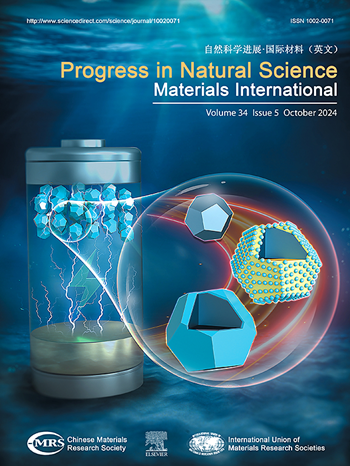Silicide precipitation behavior and dynamic recrystallization mechanism of a novel titanium alloy with widmanstatten microstructure
IF 7.1
2区 材料科学
Q2 MATERIALS SCIENCE, MULTIDISCIPLINARY
Progress in Natural Science: Materials International
Pub Date : 2025-08-01
DOI:10.1016/j.pnsc.2025.06.002
引用次数: 0
Abstract
Focusing on a new silicon-rich α+β Ti alloy with widmanstatten microstructure, the precipitation behavior of silicides and the dynamic recrystallization (DRX) mechanism during hot deformation were systematically investigated by thermal simulation compression tests. The Arrhenius constitutive model for the high-temperature deformation of the Ti-5Al-7.5V-0.5Mo-0.5Zr-0.5Si alloy was established, indicating that the DRX is the main softening mechanism. Combined with microstructure characterization, it was found that there is a certain competitive relationship between silicides precipitation and DRX, resulting in a non-monotonic change in the silicides precipitation. With the increasing temperature, the size of silicides increases, while the volume fraction first increases and then decreases. As the strain rate decreases, the size of silicides first decreases and then increases, while the volume fraction continues to decrease. The DRX fraction increases significantly at 890 °C/0.001 s−1. Additionally, the fragmentation and spheroidization of the α phase are achieved through the continuous dynamic recrystallization (CDRX). Furthermore, by integrating the dynamic material model and the relevant parameters the DRX & silicide precipitation, a novel multi-dimensional hot working map was constructed. The optimal hot processing parameters were determined as 870–884 °C/0.004–0.015 s−1, where the high-power dissipation factor η, the appropriate DRX volume fraction, and the great strengthening effect of silicides can be readily obtained, which contributed effectively to the effectively balance between the strength and plasticity of this silicon-rich Ti alloy. The investigation provides an important theoretical basis for optimizing the hot working process of silicon-rich Ti alloys and promoting the industrial application.
新型维氏组织钛合金硅化物析出行为及动态再结晶机理
以一种新型富硅α+β钛合金为研究对象,通过热模拟压缩试验,系统研究了该合金在热变形过程中硅化物的析出行为和动态再结晶机制。建立了Ti-5Al-7.5V-0.5Mo-0.5Zr-0.5Si合金高温变形的Arrhenius本构模型,表明DRX是主要的软化机制。结合微观结构表征,发现硅化物析出与DRX之间存在一定的竞争关系,导致硅化物析出呈现非单调变化。随着温度的升高,硅化物尺寸增大,体积分数先增大后减小。随着应变速率的减小,硅化物尺寸先减小后增大,体积分数继续减小。在890℃/0.001 s−1温度下,DRX组分显著增加。此外,通过连续动态再结晶(CDRX)实现了α相的破碎和球化。在此基础上,将动态材料模型与硅化物沉淀过程的相关参数相结合,构建了新型的多维热工图。确定了870 ~ 884℃/0.004 ~ 0.015 s−1的最佳热处理参数,可获得较高的功率耗散系数η、适当的DRX体积分数和硅化物的强化效果,有效地实现了该富硅钛合金强度与塑性的有效平衡。研究结果为优化富硅钛合金热加工工艺,促进其工业应用提供了重要的理论依据。
本文章由计算机程序翻译,如有差异,请以英文原文为准。
求助全文
约1分钟内获得全文
求助全文
来源期刊
CiteScore
8.60
自引率
2.10%
发文量
2812
审稿时长
49 days
期刊介绍:
Progress in Natural Science: Materials International provides scientists and engineers throughout the world with a central vehicle for the exchange and dissemination of basic theoretical studies and applied research of advanced materials. The emphasis is placed on original research, both analytical and experimental, which is of permanent interest to engineers and scientists, covering all aspects of new materials and technologies, such as, energy and environmental materials; advanced structural materials; advanced transportation materials, functional and electronic materials; nano-scale and amorphous materials; health and biological materials; materials modeling and simulation; materials characterization; and so on. The latest research achievements and innovative papers in basic theoretical studies and applied research of material science will be carefully selected and promptly reported. Thus, the aim of this Journal is to serve the global materials science and technology community with the latest research findings.
As a service to readers, an international bibliography of recent publications in advanced materials is published bimonthly.

 求助内容:
求助内容: 应助结果提醒方式:
应助结果提醒方式:


